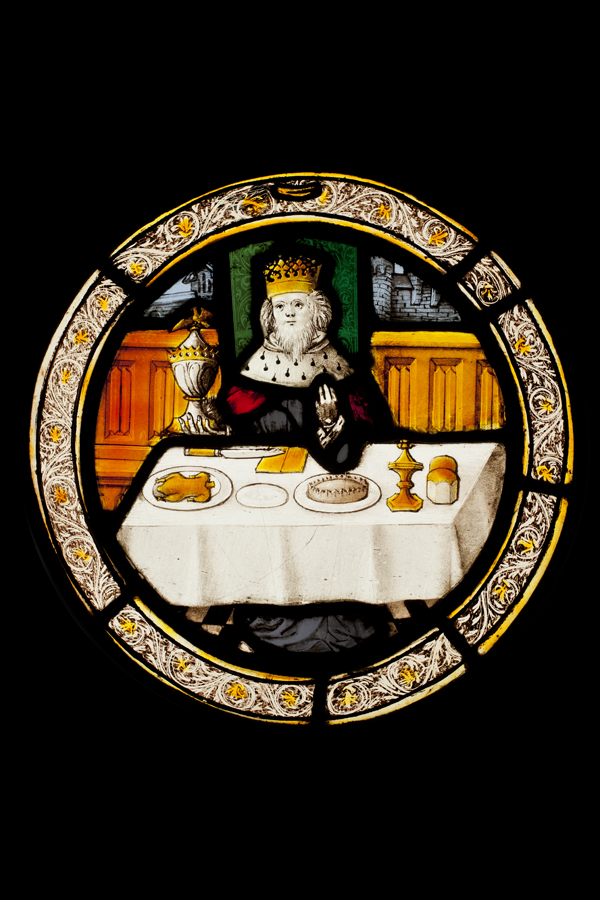roundel
Accession Number NWHCM : 2012.121
Description
roundel from set depicting Labours of the Months; king feasting at table in panelled room, table covered in linen cloth, holds poultry, a pie, bread, a gilt salt; king holds large silver gilt wine cup; may represent month of December
Read Moreroundel
This stained glass roundel depicts the month of December. It was originally part of a set of twelve roundels depicting the Labours of the Months – a popular subject in British and European medieval art, showing the rural activities that took place during the different months of the year. Apart from seasonal tasks such as sowing, reaping, pruning or harvesting, ‘labours’ subjects could sometimes be less purely work-oriented, and include scenes of feasting, sitting by the fire, hawking or courtly love.
Eight of the original twelve roundels survive: four are in our collection; two are in the Victoria and Albert Museum and two are now in a private collection. The four roundels in the collection of Norwich Castle Museum & Art Gallery depict the months of March, September, April/November and December/January. March and September illustrate the agricultural tasks of pruning trees and harvesting grapes. April/November shows a man taking shelter from a hailstorm in a building, and December/January depicts a king feasting. It has not so far been possible to identify with certainty exactly which months these last two roundels represent.
The cycle of twelve roundels was probably made in Norwich at the beginning of the 16th century. They are likely to have been made originally in about 1525 for the house of Thomas Pykerell (d.1545), a merchant, Sheriff and Mayor in Norwich. This house still stands in Rosemary Lane, although the roundels were moved in the mid-nineteenth century.
The first known record of glaziers working in Norwich is from 1241, although they may have been working in the city earlier. By the 15th century Norwich had one of the most flourishing schools of glass painting in England. The glass produced by Norwich workshops is characterised by a lively drawing style, an emphasis on red and white glass used with yellow stain, and distinctive renditions of motifs such as architectural features, angels’ feathers, foliage and landscapes. The majority of surviving Norwich stained glass illustrates religious subjects. There are few surviving examples of Norwich-made stained glass showing secular subjects, but the Labours of the Months were clearly very popular as a few other roundels on this theme survive.
These roundels are technically and artistically very accomplished. The faces are full of character, and the figures show a strong Flemish influence in their high degree of naturalism. Stained glass makers from the Low Countries are known to have worked in Norwich. John Wattok, who was of Dutch origin and active during the period c.1495-1540, is the most likely maker of this set of roundels. His workshop was near Rosemary Lane.
This roundel of a king feasting probably represents the month of December. According to the 18th-century historian of Norfolk, Francis Blomefield, there was an annual pageant held in Norwich, in which representatives of each monthly labour took part. The festivities were presided over by ‘the King of Christmas’, who led the procession. It is possible therefore that the king illustrated in the December/January roundel may represent this ‘King of Christmas’, who symbolised the festive season.
The elderly white-haired king sits at a cloth-covered table on which a meal and a knife have been laid. He wears a crown, an ermine-lined red cloak and grey-blue robe and holds a covered golden vessel. His head is framed by a green damask cloth-of-honour. Behind the linen-fold panelling, fortified castle walls are visible. The floor beneath the table is of chequered black and white tiles. Chequered paving was a very common motif in English stained glass and is found in church stained-glass across Norfolk. The whole image is surrounded by a circular frame of scrolling white leaves with yellow flowers. This is also a motif used frequently by Norfolk glass painters, as well as wood carvers and painters. Some of the individual panes of glass which make up each roundel are stained and painted, like the green cloth behind the king. Other portions, like the patterned borders, are painted in yellow and black onto colourless ‘white’ glass.
The king’s meal tells us about customs of the time. Items on the table include a roasted bird, a white loaf, a decorated pie and gold and silver vessels. The silver-gilt wine cup and standing hourglass salt correspond stylistically to the late Gothic period and so are near-contemporary with the roundels, again demonstrating a degree of direct observation typical of the Flemish style of this period. The fashionable silver vessels would all have been part of a rich man’s dinner table of the time, which included displays of precious metal as a statement of wealth and power. This type of food and setting would have been familiar to the roundels’ probable first owner, Thomas Pykerell, who would have dined in similar style. It is thought the roundels were set into the walls of the Great Hall of his house, so he would have seen them while he ate.
During the medieval period, stained glass was an expensive luxury but these roundels were made at a time of economic growth in Norwich. With the advent of the Tudor dynasty after the long uncertainty of the Wars of the Roses, increased political stability meant a corresponding increase in consumer spending. There was a growing number of successful merchants like Thomas Pykerell keen to display their wealth and status who were able to commission expensive objects like these to decorate their homes.


